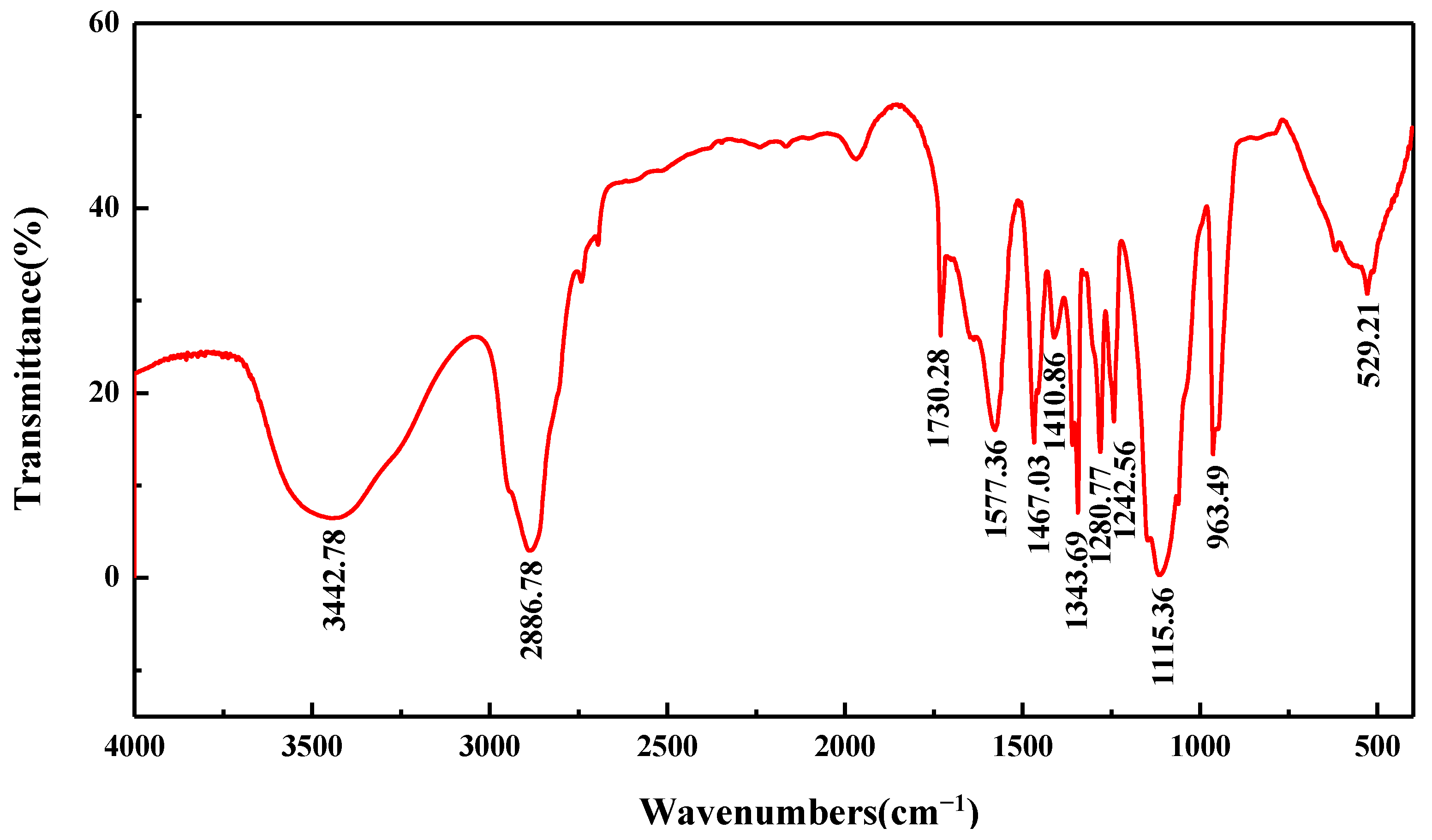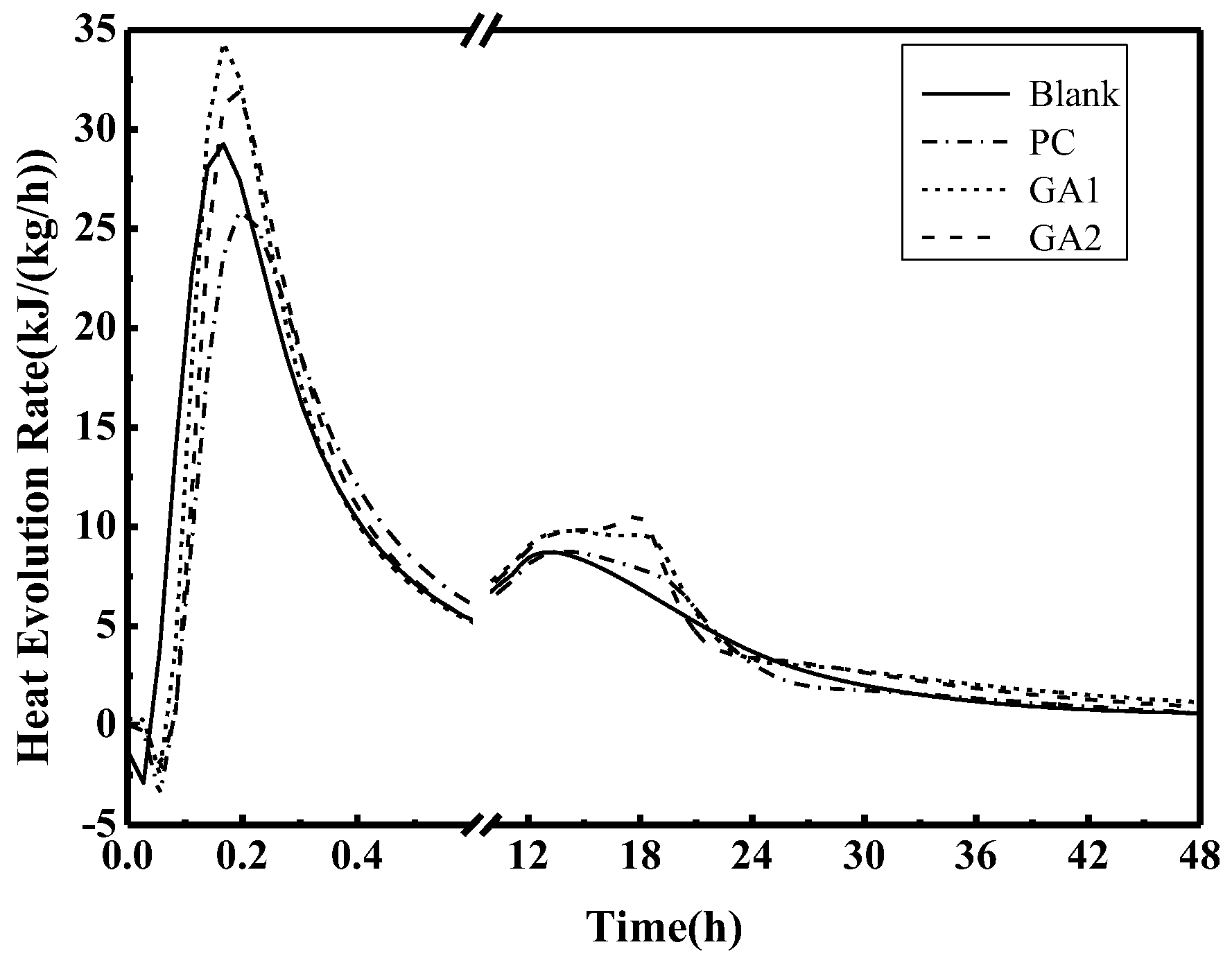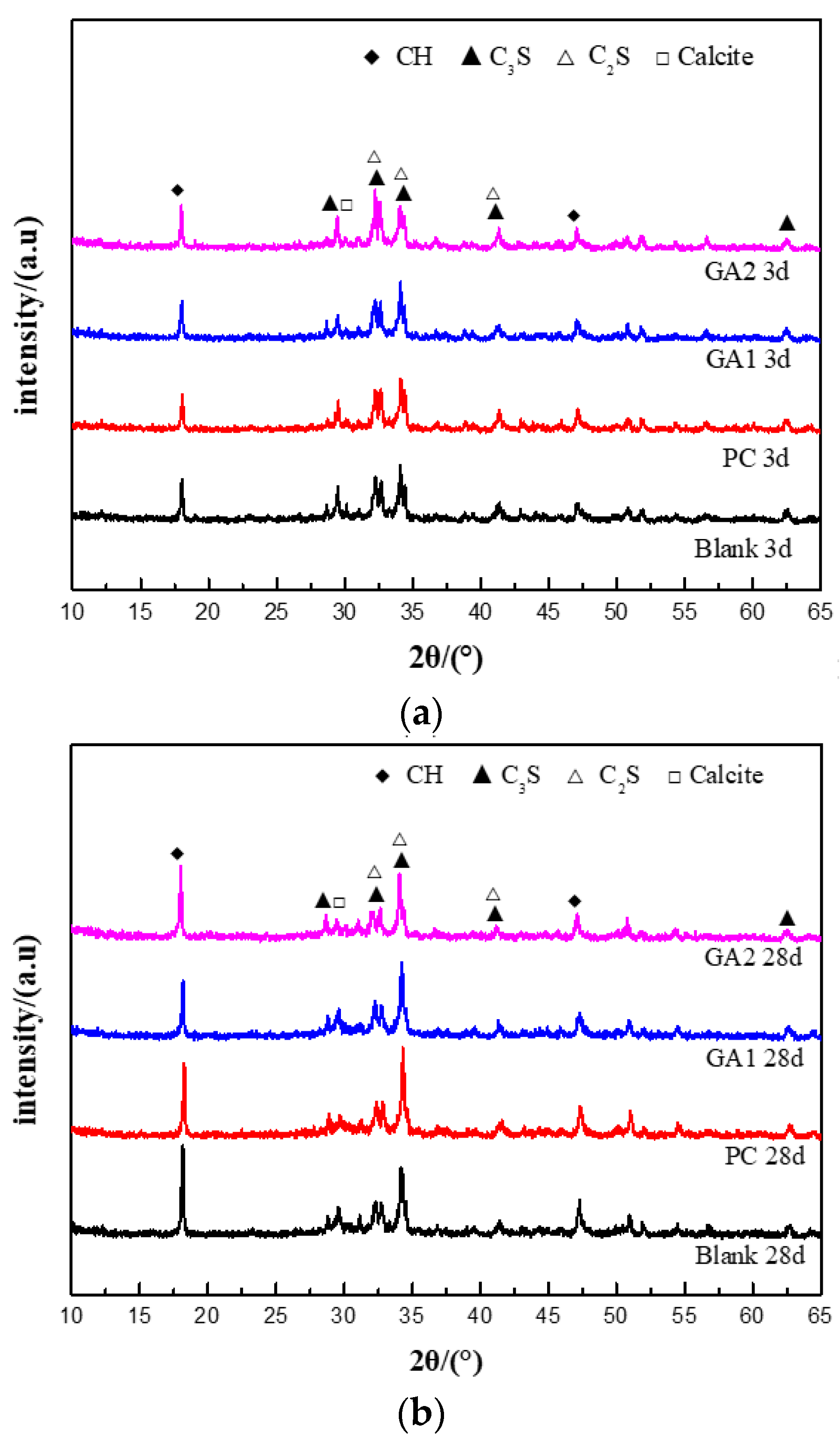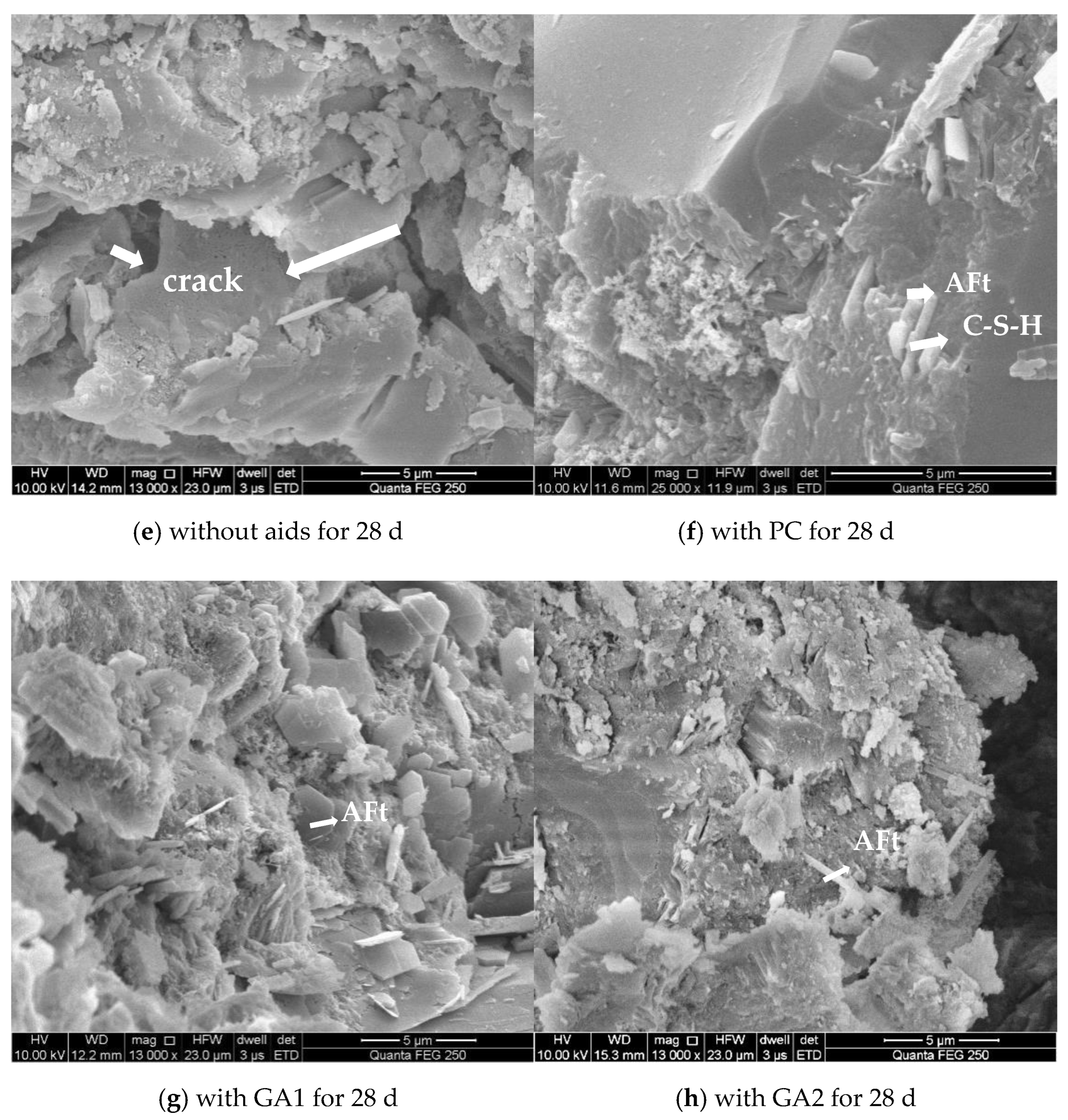Effect of Polycarboxylic Grinding Aid on Cement Chemistry and Properties
Abstract
1. Introduction
2. Experiment and Characterization
2.1. Raw Materials
2.2. Synthesis Process
2.3. Characterization
3. Results and Discussion
3.1. Characterization of PC
3.2. Particle Size Distribution
3.3. Mechanism Analysis
3.4. Cement Paste Fluidity
3.5. Cement Strength Development
3.6. Thermal Analysis during Cement Hydration and XRD Analysis
3.7. SEM Observation
4. Conclusions
Author Contributions
Funding
Institutional Review Board Statement
Informed Consent Statement
Data Availability Statement
Conflicts of Interest
References
- Lin, B.; Zhang, Z.; Ge, F. Energy Conservation in China’s Cement Industry. Sustainability 2017, 9, 668. [Google Scholar] [CrossRef]
- He, J.; He, J.; Wang, Y.; Fan, Y.; Shi, H.; Cai, B.; Yan, G. Pathway of Carbon Emissions Peak for Cement Industry in China. Res. Environ. Sci. 2022, 35, 347–355. [Google Scholar]
- Mirzakhani, M.A.; Tahouni, N.; Panjeshahi, M.H. Energy Benchmarking of Cement Industry, based on Process Integration Concepts. Energy 2017, 130, 382–391. [Google Scholar] [CrossRef]
- Altun, O. Energy and cement quality optimization of a cement grinding circuit. Adv. Powder Technol. 2018, 29, 1713–1723. [Google Scholar] [CrossRef]
- Ghiasvand, E.; Ramezanianpour, A.A. Effect of grinding method and particle size distribution on long term properties of binary and ternary cements. Constr. Build. Mater. 2017, 134, 75–82. [Google Scholar] [CrossRef]
- Plank, J.; Sakai, E.; Miao, C.W.; Yu, C.; Hong, J.X. Chemical admixtures—Chemistry, applications and their impact on concrete microstructure and durability. Cem. Concr. Res. 2015, 78, 81–99. [Google Scholar] [CrossRef]
- Yanmei, G.; Shaofei, S. The effect on the Performance of Cement Grinding Aid Components. In Proceedings of the 2018 4th Workshop on Advanced Research and Technology in Industry Applications (WARTIA 2018), Dalian, China, 28–29 September 2018; pp. 267–274. [Google Scholar]
- Huang, J.M.; Chen, P.; Xia, M.G. Preparation and Propety Research of Polymaleic Acid Salts Cement Grinding Aids. B. Chin. Ceram. Soc. 2015, 34, 1431–1434+1439. [Google Scholar]
- Toprak, N.A.; Altun, O.; Benzer, A.H. The effects of grinding aids on modelling of air classification of cement. Constr. Build. Mater. 2018, 160, 564–573. [Google Scholar] [CrossRef]
- Prziwara, P.; Kwade, A. Grinding aids for dry fine grinding processes–Part I: Mechanism of action and lab-scale grinding. Powder Technol. 2020, 375, 146–160. [Google Scholar] [CrossRef]
- Shaheen, F.; Pradhan, B. Role of chloride ion and cation type accompanied by sulfate ion on durability performance of concrete in conjoint chloride–sulfate environment. J. Mater. Civ. Eng. 2020, 32, 04020264. [Google Scholar] [CrossRef]
- Pendergrass, B.; Darwin, D.; Feng, M.; Khajehdehi, R. Compatibility of Shrinkage-Reducing and Air-Entraining Admixtures. ACI Mater. J. 2017, 114, 809–818. [Google Scholar] [CrossRef][Green Version]
- Teixeira, M.M.; de Azevedo, A.R.G.; de Matos, P.R.; Neves, M.S.; Fontes, V.C.M. Materials for Production of High and Ultra-High Performance Concrete: Review and Perspective of Possible Novel Materials. Materials 2021, 14, 4304. [Google Scholar] [CrossRef]
- Liu, L.; Pu, X.; Rong, K.; Yang, Y. Comb-shaped copolymer as filtrate loss reducer for water-based drilling fluid. J. Appl. Polym. Sci. 2018, 135, 45989. [Google Scholar] [CrossRef]
- Sevim, O.; Kalkan, İ.; Demir, İ.; Akgüngör, A.P. Effects of the sole or combined use of chemical admixtures on properties of self-compacting concrete. Arch. Civ. Mech. Eng. 2021, 21, 1–14. [Google Scholar] [CrossRef]
- Bao, L.; Liguo, W.; Ganghua, P.; Dongxu, L. Dispersion of graphene oxide modified polycarboxylate superplasticizer in ce-ment alkali solution for improving cement composites. J. Build. Eng. 2022, 57, 104860. [Google Scholar]
- Liu, X.; Xu, Q.; Ma, X.; Zheng, Y.; Lu, L.; Bai, X. A novel method for solving the impact of clay on concrete workability: Dimensional design and mechanism analysis. Clay Miner. 2020, 55, 53–62. [Google Scholar] [CrossRef]
- Taifunisyam, T.; Rafie, J.M.; Jefrey, B.W. Enhanced Optical and Ragged Metamaterials Properties of Silver Silica Nanocomposite Thin Film via Sol-Gel and Electrophoresis Deposition Technique. J. Nano Res. 2022, 74, 11–24. [Google Scholar]
- Yan, Z.; Huaqing, L.; Jialing, L.; Sen, K.; Chao, D. Mechanical property and hydration kinetics of slag-fly ash blends activated with trisopropanolamineand sodium carbonate. New Build. Mater. 2022, 49, 104–109. [Google Scholar]
- Altun, O.; Benzer, H.; Toprak, A.; Enderle, U. Utilization of grinding aids in dry horizontal stirred milling. Powder Technol. 2015, 286, 610–615. [Google Scholar] [CrossRef]
- Zhang, T.; Gao, J.; Hu, J. Preparation of polymer -based cement grinding aid and theirperformance on grindability. Constr. Build. Mater. 2015, 75, 163–168. [Google Scholar] [CrossRef]
- Yang, H.; Plank, J.; Sun, Z. Investigation on the optimal chemical structure of methacrylate ester based polycarboxylate superplasticizers to be used as cement grinding aid under laboratory conditions: Effect of anionicity, side chain length and dosage on grinding efficiency, mortar workability and strength development. Constr. Build. Mater. 2019, 224, 1018–1025. [Google Scholar]
- Haijun, X. Development of β-Cyclodextrin Clay Inhibitory Polycarboxylic Acid Superplasticizer and Its Dispersion Effect; South China University of Technology: Guangzhou, China, 2017. [Google Scholar]
- He, Y.; Zhang, X.; Wu, G.; Shi, P. Effects of Polycarboxylate-based Grinding Aid on the Performance of Grinded Cement. J. Wuhan Univ. Technol.-Mater. Sci. Ed. 2021, 36, 682–688. [Google Scholar] [CrossRef]
- Sun, Z.; Yang, H.; Shui, L.; Liu, Y.; Yang, X.; Ji, Y.; Hu, K.; Luo, Q. Preparation of polycarboxylate-based grinding aid and its influence on cement properties under laboratory condition. Constr. Build. Mater. 2016, 127, 363–368. [Google Scholar] [CrossRef]









| Grinding Aid | Particle Size Distribution (wt%) | Average Particle Size (μm) | |||
|---|---|---|---|---|---|
| 0–3 μm | 3–32 μm | <45 μm | >65 μm | ||
| Blank | 2.70 | 59.57 | 77.07 | 11.39 | 33.28 |
| PC | 2.43 | 64.58 | 80.92 | 9.25 | 29.63 |
| GA1 | 2.75 | 65.88 | 83.14 | 7.17 | 29.21 |
| GA2 | 3.25 | 69.31 | 85.11 | 8.96 | 28.58 |
Publisher’s Note: MDPI stays neutral with regard to jurisdictional claims in published maps and institutional affiliations. |
© 2022 by the authors. Licensee MDPI, Basel, Switzerland. This article is an open access article distributed under the terms and conditions of the Creative Commons Attribution (CC BY) license (https://creativecommons.org/licenses/by/4.0/).
Share and Cite
Yang, J.; Li, G.; Yang, W.; Guan, J. Effect of Polycarboxylic Grinding Aid on Cement Chemistry and Properties. Polymers 2022, 14, 3905. https://doi.org/10.3390/polym14183905
Yang J, Li G, Yang W, Guan J. Effect of Polycarboxylic Grinding Aid on Cement Chemistry and Properties. Polymers. 2022; 14(18):3905. https://doi.org/10.3390/polym14183905
Chicago/Turabian StyleYang, Jianyu, Guanglin Li, Weijun Yang, and Junfeng Guan. 2022. "Effect of Polycarboxylic Grinding Aid on Cement Chemistry and Properties" Polymers 14, no. 18: 3905. https://doi.org/10.3390/polym14183905
APA StyleYang, J., Li, G., Yang, W., & Guan, J. (2022). Effect of Polycarboxylic Grinding Aid on Cement Chemistry and Properties. Polymers, 14(18), 3905. https://doi.org/10.3390/polym14183905







